We’ve just returned from our third Portugal tour and are simply thrilled. Portugal has so much to offer. Whether it’s traditional villages, relaxed cities like Lisbon or Porto, countless beaches, cliffs, great waves for surfing, and much more. It’s never boring in Portugal; there’s always something new to discover.
The country is also ideal for a road trip. All you need to do is rent a car or campervan, and you’re ready to go. Today we’re taking you to our absolute favorite country and giving you information and tips for your own Portugal tour. Have fun browsing and following along!
- The best time to travel to Portugal
- Arrival & City Trip
- Rent a car in Portugal
- Rent a camper in Portugal
- Campsites in Portugal
- Toll roads in Portugal
- Withdraw money in Portugal
- Shopping & Supermarkets
- Book accommodation
- Packing list for your road trip
- Portugal round trip – From Lisbon to the Algarve
- Portugal round trip – From Porto to Lisbon
- Conclusion of a Portugal round trip
The best time to travel to Portugal
The best time to travel to Portugal is definitely the off-season, from March to May and from September to the beginning of November. There’s obviously a lot more going on in the summer months and during the holiday season, which is why we like to travel there during the quieter months. In general, however, you can travel through the country all year round; the climate is quite mild and pleasant even outside of peak season. Temperatures in the off-season range between 18 and 25 degrees Celsius. It usually gets quite cool in the mornings and evenings, so a thicker jacket is a good idea.

In July, August, and September, temperatures can quickly reach a summery, hot 35 degrees Celsius. The coldest months are December and January, with average temperatures of just 15 degrees Celsius. The peak travel season for Portugal is between June and September. Outside of these months, you can also expect cheaper prices in Portugal. No matter what you decide, a trip through this country is worthwhile at any time of year! You can find a detailed article about this here: Best time to travel to Portugal.
Arrival & City Trip
You’ll most likely arrive by plane. Many airlines like Ryanair, Easyjet, Eurowings, Lufthansa, or TAP will take you to Porto, Faro, or Lisbon at a reasonable price. The flight usually takes just under 3 hours. If you want to fly to Lisbon, you can fly cheaply from Frankfurt, Bremen, Karlsruhe, Hamburg, Berlin, or Cologne. It’s a bit more expensive from Munich, Stuttgart, and Düsseldorf. Depending on the month you travel, you can get a round-trip flight for an incredible €40.
Porto is also easy to reach. You can fly from Bremen, Düsseldorf, Frankfurt, Cologne, Karlsruhe, Nuremberg, Hamburg, Dortmund, Berlin, Memmingen, or Stuttgart. It’s significantly more expensive from Munich. A round-trip flight to Porto costs around €35. You can also fly directly to Faro in the Algarve. Flights depart from Frankfurt, Cologne, Düsseldorf, Hamburg, Memmingen, or Bremen. Flights are more expensive from Berlin, Stuttgart, Friedrichshafen, and other airports. You can get to Faro and back for under €30.
Where you fly depends, of course, on your planned itinerary. Don’t have any idea where to go yet? Below, we’ll introduce you to two great routes. You’re sure to find what you’re looking for! Before you start your actual tour of Portugal, it’s a good idea to explore the city you’ve landed in. Whether it’s Porto, Lisbon, or Faro, it’s definitely worth planning a day or two just for these cities. You don’t need a car there; all cities have good public transportation; otherwise, we also like to use the Uber app.
Renting a Car in Portugal
The best way to explore the country is, of course, with your own rental car. This gives you great flexibility, the roads are well-maintained, and rental cars are inexpensive. Prices depend on the travel season; on average, you can expect to pay around €10 per day. We always book a car online in advance and compare prices. It’s always important to us to select “fully comprehensive insurance with no excess” and the “full/full” fuel policy.

You should check additional insurance policies in detail and decide for yourself which you consider necessary. Depending on the rental company, a deposit may be required upon pick-up, which you can only pay with a credit card. Last time, we had to deposit a whopping €1,200 in Lisbon. So make sure your credit card limit is sufficient.
In Faro, Porto, and Lisbon, you can pick up your rental car directly at the airports. Of course, you can also find rental car stations within the cities. Crossing the border into Spain is usually not a problem. However, you should clarify this with your rental company beforehand. Portugal also has some beautiful islands. Ferry crossings with a rental car are usually very expensive, and sometimes even prohibited. You should also talk to your rental company beforehand about this.
Renting a camper in Portugal
A camper, of course, offers an even greater feeling of freedom. Sleeping right by the sea and then enjoying a relaxed breakfast there is the pinnacle of slowing down. These days, you can easily search for and book a suitable camper or bus from the comfort of your own home. We’ve included everything on this topic in a separate post: Renting a Camper in Portugal (…coming soon). We’ve also written a detailed post on Camping in Portugal. There you’ll find all the information and tips for your road trip.
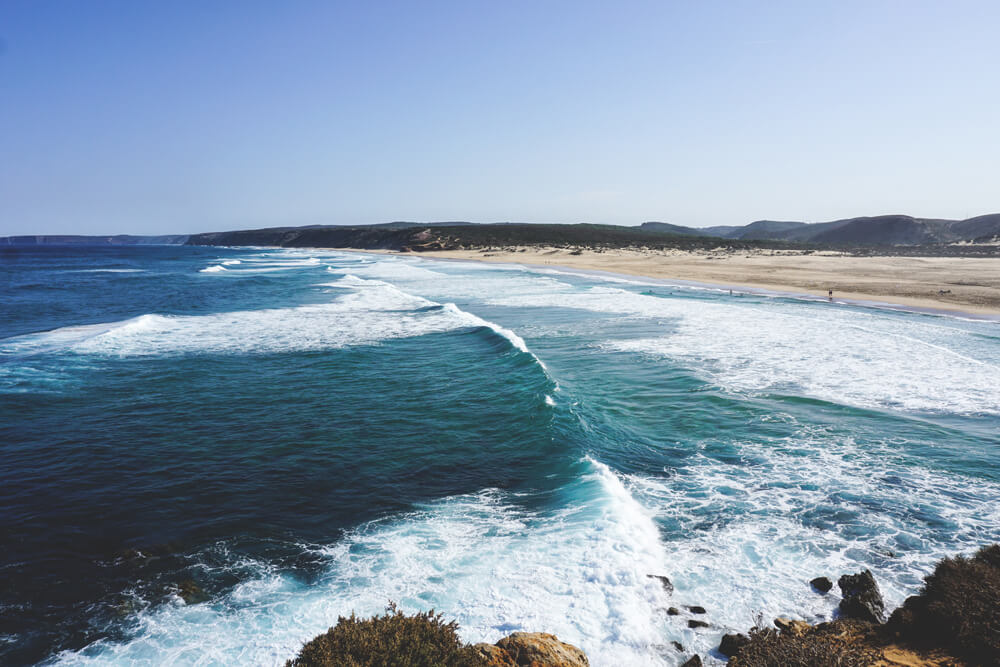
Campsites in Portugal
Officially, “wild camping” is not permitted in Portugal. You are not allowed to pitch your tent on private property, nor are you allowed to park your caravan or campervan in parking lots or rest areas. Officially! But things are often much more relaxed on the ground. During our tours through Portugal, we had no problems and were always able to find a quiet place. There are larger parking lots everywhere, where several campers and caravans were parked. It really didn’t bother anyone. You should just forget about “camping” and really just “park” your camper there, and not bring out the tables and chairs.
The good thing about proper campsites is that you can use the on-site sanitary facilities. You can also use electricity, water, pools, playgrounds, shops, and restaurants. Especially in the north of the country or on the edge of the Algarve (Lagos, Motto Gordo), you’ll find good spots for your camper, caravan, or tent. You can find a good overview here: ☞ ADAC Camping in Portugal.
With the ☞ Camping Card, you can camp for less and receive discounts at participating campsites upon presentation. For example, you’ll pay only €11 to €19 per night for two people. The Camping Card is accepted at over 3,330 campsites in 21 European countries. Three children up to 5 years old travel free at over 650 campsites. You can purchase the card online for €16.95.
Toll Roads in Portugal
Portugal also has several toll roads. On the motorways (AE), there are various toll booths where you pay the fees depending on the section of the route. You can find an overview of toll stations and costs here: Portugaltolls.com (English). From Lisbon to Faro, for example, it’s around €17 for a car and €30 for a campervan. You can pay at the toll booths in cash or by credit card. On some routes (particularly in the Algarve), however, electronic tolls are collected.
These are marked with a blue sign that says “electronic toll only” (an electronic device is required here). Almost all rental cars are equipped with such a device, but please discuss this with the rental company directly when picking up the car. You will then be billed directly through the car rental company. The following section is only of interest to you if you plan to travel to Portugal with your own car:
Easy Toll
There are four electronic payment systems. For stays of up to 30 days, Easy Toll is recommended if you have a credit card. When entering the country by car, you must go directly to a Welcome Point near the border. There you will find payment stations where you enter your credit card. Your license plate will then be photographed and linked to your credit card. All applicable tolls will then be debited directly from your card.
TollService
For a short trip to Portugal, TollService is suitable. This is a type of prepaid card that you can top up with credit. Once activated, the card is valid for one year. You can get such a card at many gas stations (e.g., along the A24), at airports, and post offices.
TollCard
If you travel frequently in Portugal, the TollCard might be suitable for you. It is valid for one year and can be topped up with €5, €10, €20, or €40. Here, too, your license plate is linked to the card. You can get the TollCard at Portuguese Post offices, motorway gas stations, and online. However, this card is only valid on motorways without toll booths. If there is a toll booth, you must pay in cash.
Via Verde Visitor
The Via Verde Visitor transmitter is suitable for longer stays in the country and is valid for 90 days. This transmitter is attached to the front of the car and linked to your credit card. You can also top up your credit directly with a minimum of €10. The rental fee for this transmitter is €6 for the first week and then €1.50 for each additional week.
If you rent the device, you will need to pay a deposit of €27.50. You can get the transmitter at post offices, motorway gas stations, Via Verde distributors, or online. Only with this transmitter are you allowed to use the Via Verde lane on motorways. You can recognize this lane by a white V on a green background.
If you don’t want to pay tolls, you are only allowed to use the country roads/secondary roads. However, if you have enough time, we recommend these roads anyway (e.g., the N120 towards the southern west coast and the Algarve). You’ll see more there than on the motorways. We usually don’t use toll roads at all, and if we do, it’s only to get from A to B as quickly as possible. There are great routes along the coast that are definitely more worthwhile than the highways.
Withdrawing money in Portugal
In Portugal, you can easily and conveniently withdraw cash from ATMs. We have been using the DKB credit card for over 8 years. We are simply extremely satisfied with the service and account management. As an alternative, we always carry the reloadable Mastercard from N26. We are also totally happy with this card. For card payments in Portugal, the major credit cards VISA, Mastercard, American Express, and Diners Club are accepted.
You can also use debit cards with the Maestro or Cirrus logo. However, check with your bank beforehand to see if there are any fees and, if so, how much they are for card payments abroad. You can find ATMs (Caixa Automático) in virtually every town, city, and most tourist spots.
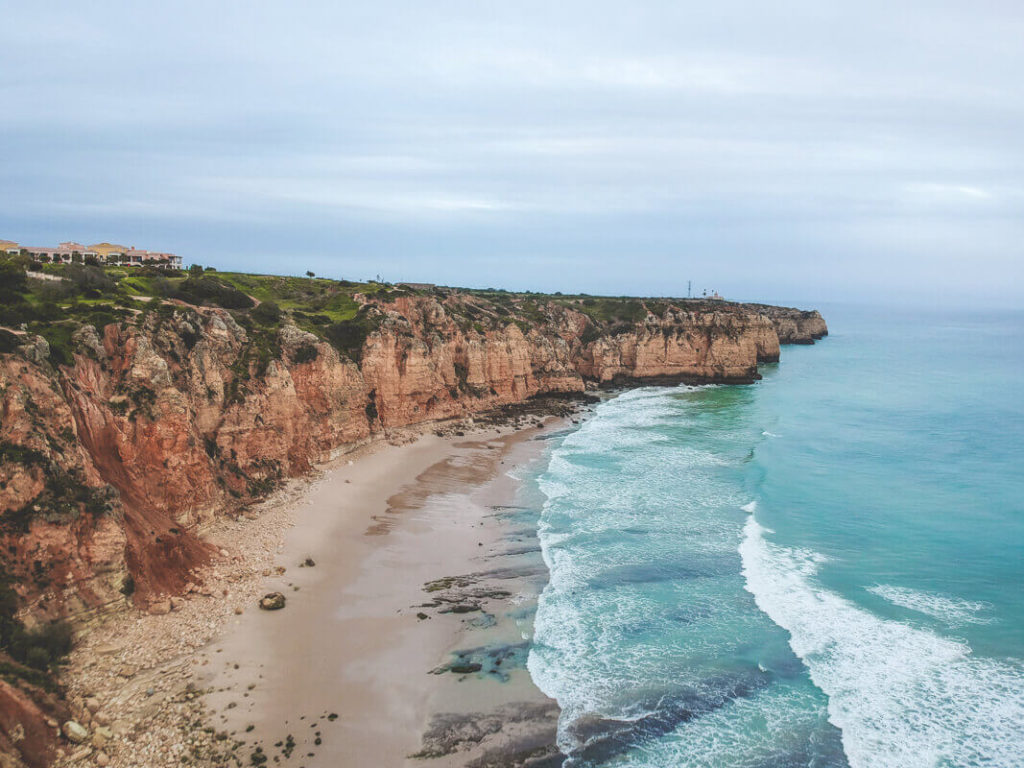
Shopping & Supermarkets
Shopping in Portugal is just as easy as it is in Germany. There are various local supermarket chains such as LIDL, Aldi, Intermaché, Continente, SPAR, Coviran, and others. Here, you can get practically anything your heart desires. Prices aren’t that different from Germany. As always, some products are more expensive, while others are cheaper.
In the Intermaché markets, you can get a good and inexpensive breakfast (croissant + coffee) from the bakery. You can also use the restroom there if you’re traveling with a camper. Large supermarkets usually have washing machines and dryers at the entrance. You can wash and dry your laundry there for €6. As you can see, Portugal is ideally suited to camping tourism.
Booking Accommodation
If you’re traveling with a rental car and need accommodation locally, check out Booking.com or Airbnb. You’ll find tons of accommodation options there. You can get a shared room in a hostel for as little as €10 per person, depending on the region. There are also really cool and stylish hostels in Porto and Lisbon. Airbnb offers super cool apartments and private rooms. But you’ll also find something for every budget in the country’s other cities.
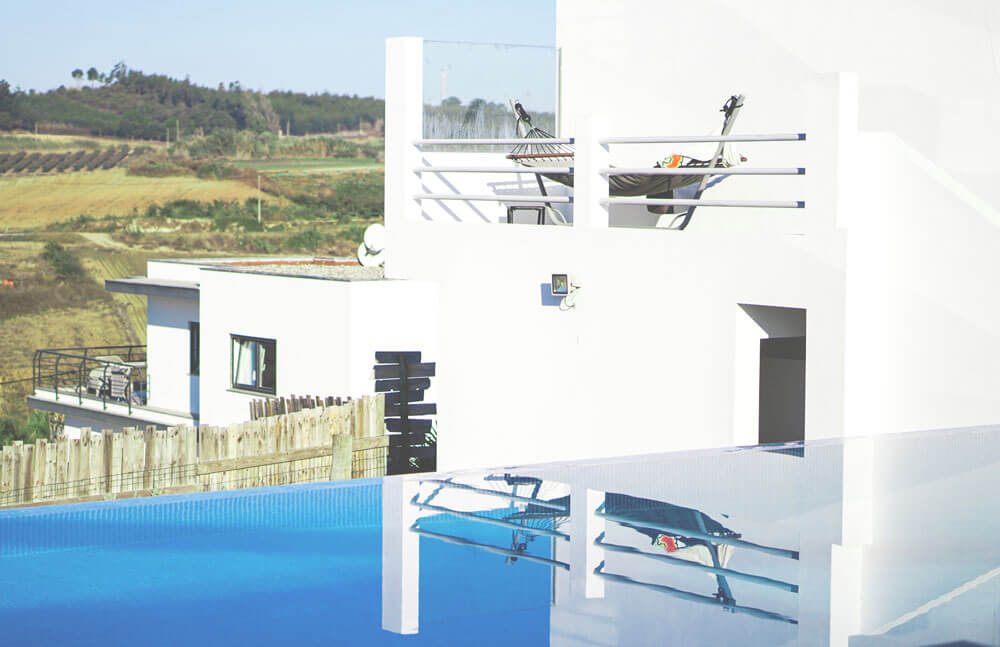
You can also couchsurf in Portugal – give it a try! If you don’t have an Airbnb account yet, you can set one up using our invitation link. As a new customer, you’ll receive a full €30 discount on your first booking. This usually qualifies for a free overnight stay. We’ve had nothing but good experiences with Airbnb over the past three years. There was only one unfortunate incident in Malaysia, which we were able to resolve quickly with Airbnb’s help.
Packing list for your road trip
Depending on the month you’re traveling, you should bring different clothes and items with you on your road trip. The winter months can be rainy and really cold. In summer, however, it can get really hot. We were in the country in May, October, and April. The weather was generally the same: warm days, hot days, and also cool to cold days with rain and fog.
These days, we always like to take a few more clothes, as in the end, a sweater and a pair of pants weren’t enough. When it comes to clothing, you have to decide for yourself what you feel most comfortable in and what you want to pack in your backpack. Therefore, we don’t link to any shirts, shoes, pants, or underwear here. Rather, we’ll show you which gadgets are really cool and helpful.
Our must-haves for a road trip:
- For the perfect sound: Music box
- For emergencies: LED lamp (solar or battery-powered)
- Charging batteries in the car: USB hub
- Mosquito spray and sunscreen
- Wetsuit & surfboard (One week from €90 in the Algarve)
- Card games (our favorites Qwantum and Ganz schön Clever)
- Foldable water bottles (very practical, even for flights)
- Pocket knife (no knife in hand luggage)
- Microfiber towels (dry quickly and save space)
- Clothesline and pegs for traveling
- Hammock for Chilling
Portugal Round Trip – From Lisbon to the Algarve
Of course, everyone has their own idea of where their trip should go. For example, you can start in Porto in the north and drive to Lisbon or even to the Algarve. You can also start in Lisbon and drive to Porto, or just take a short road trip along the beautiful Algarve.
We’ve already done a few common routes. For inspiration, we’ll now present two routes. We’ll take you on a cool 7-day Portugal Road Trip from Lisbon to the Algarve and further to the southern west coast. This way, you can decide for yourself which places appeal to you and make your shortlist.
Sightseeing in Lisbon
Of course, the trip begins with a detour to Portugal’s capital. On foot, you can spend the day relaxing through the streets, checking out some viewpoints (miradouros), and discovering cool spots. We’ve been to Lisbon three times so far and simply love the city’s flair. Admiring the view from one of the many terraces at sunset – a dream!

Don’t feel like sightseeing in the city? You can also get to the beaches outside the city by train. Towards Cascais, there are countless beaches where you can swim and surf. Cascais itself is a great place to stroll along the beach and dine in one of the cliff-top restaurants. A quick tip: A visit to “Boca do Inferno.”
Pure Algarve in Lagos
Afterward, it’s time to head toward the Algarve. Remember the tolls (see the Tolls chapter) or drive along the coast to the south. If you do the latter, be sure to make a detour to Monte Clerigo and Arrifana! More on that later. We chose Lagos as our starting point in the Algarve and were really happy with it. From there, we could easily explore every corner.
Lagos has a lot to offer and is a beautiful seaside town. In addition to the old town, there are some of the famous rock formations that are so typical of the Algarve. Be sure to visit Ponta da Piedade. This viewpoint is extremely touristy, but you can’t blame anyone. The view of the cliffs is simply stunning. Definitely one of the most beautiful spots in the Algarve.
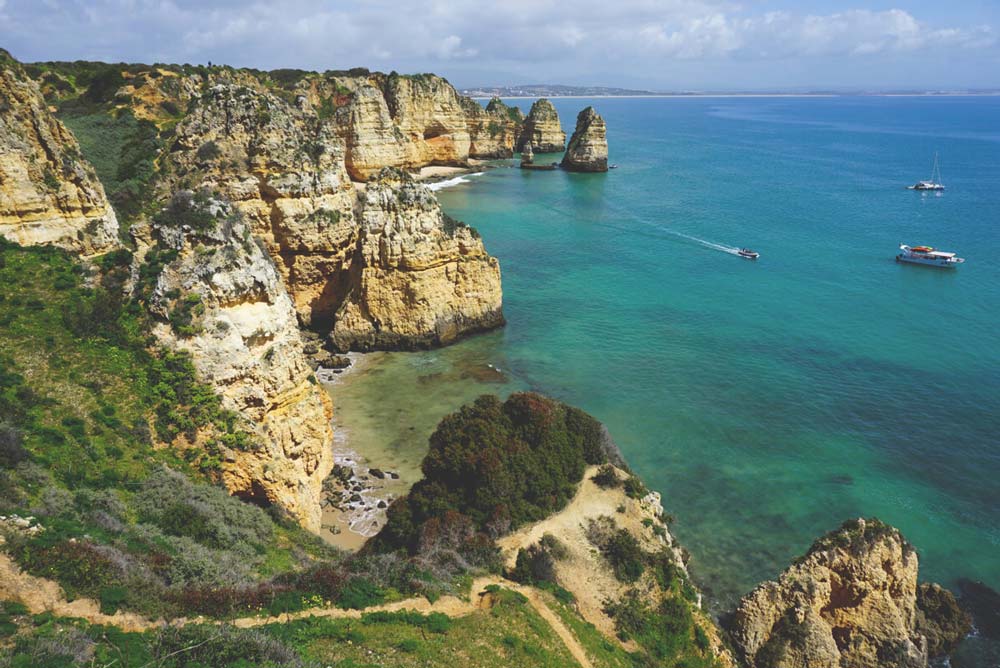
At Praia de Mos Beach, there’s a large public gravel parking lot where we and a few others were able to park undisturbed for two days (GPS: 37.086620, -8.688464). There’s no electricity or other amenities there, but there’s at least a toilet and a shower (when it works). You’ll find these right in front of the entrance to the Antonio Restaurant.
Charming fishing village of Burgau
Our tour took us to the beautiful little fishing village of Burgau. This place is located directly on the Atlantic coast and impresses with beautiful, typical local impressions. Here you’ll find small, narrow, and winding streets, a few charming restaurants and shops, and a beautiful sandy beach. It was barely busy (in April), with only a few visitors enjoying the warm sun on the beach. We thoroughly enjoyed our time there and found this place to be very quiet, relaxing, and peaceful.
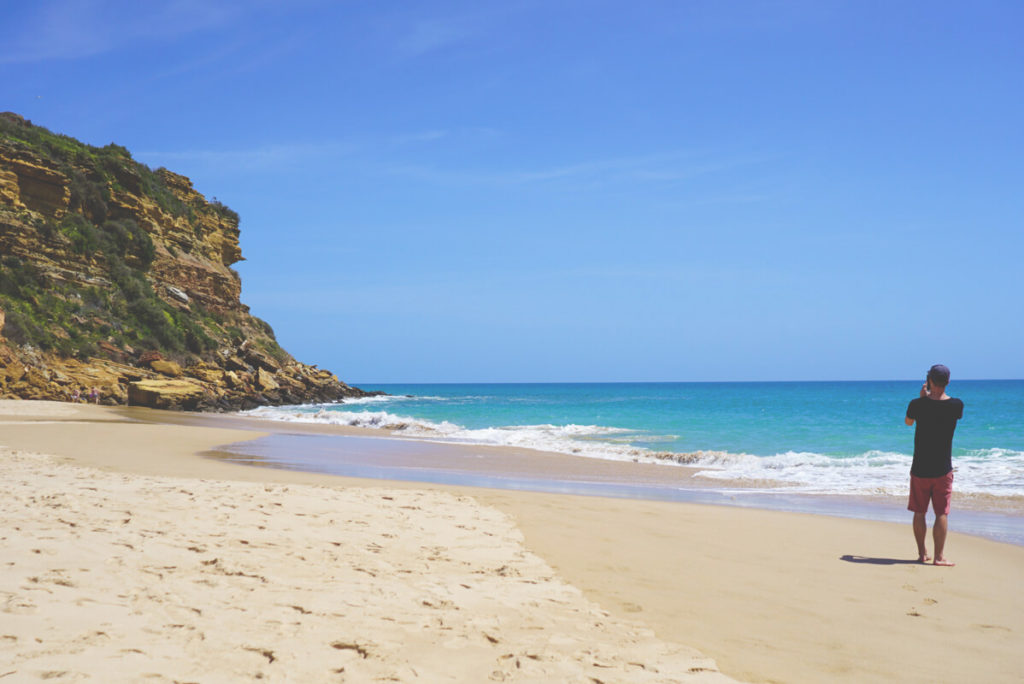
Sagres & Cabo de São Vicente
Almost every vacationer stops in Sagres on their way to the west coast. Why? Because it’s the southwesternmost point of Europe (Cabo de São Vicente). It’s just under a 35-minute drive from Lagos. Here, you’ll be greeted by steep cliffs, the rough Atlantic, and meter-high waves. The port town of Sagres is located on a rocky plateau. You can visit the legendary Fortaleza de Sagres during the day.
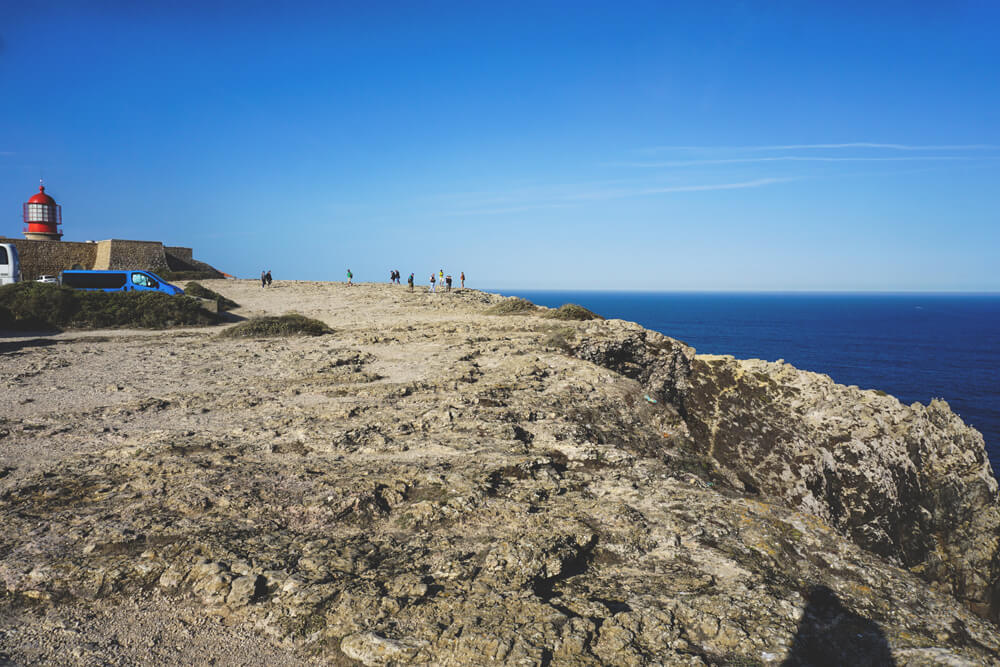
If you’re in the mood for a snack, the almost famous food truck with the slogan “The Last Sausage Before America” is located right on the plateau. The nearest beaches are: Praia da Baleeira, Praia do Martinhal, Praia do Beliche, Praia da Mareta, and Praia do Tonel. Praia do Beliche is particularly beautiful with its magnificent cliffs all around. There’s also a campsite in Sagres (Camping & Bungalows Orbitur Sagres). You only pay around €5.20 for a campervan pitch.
Beach life in Cordoama
We continued along the coast in our beautiful bus. Eventually, we reached the pretty Praia da Cordoama. This beach is located just 14 km from Sagres and is framed by rugged cliffs and rock formations in a beautiful bay. The kilometer-long beach invites you to relax and linger. You can also surf here if you’re up for bigger waves. Just before the beach is the Bar Da Praia, where you can enjoy inexpensive food and drinks.
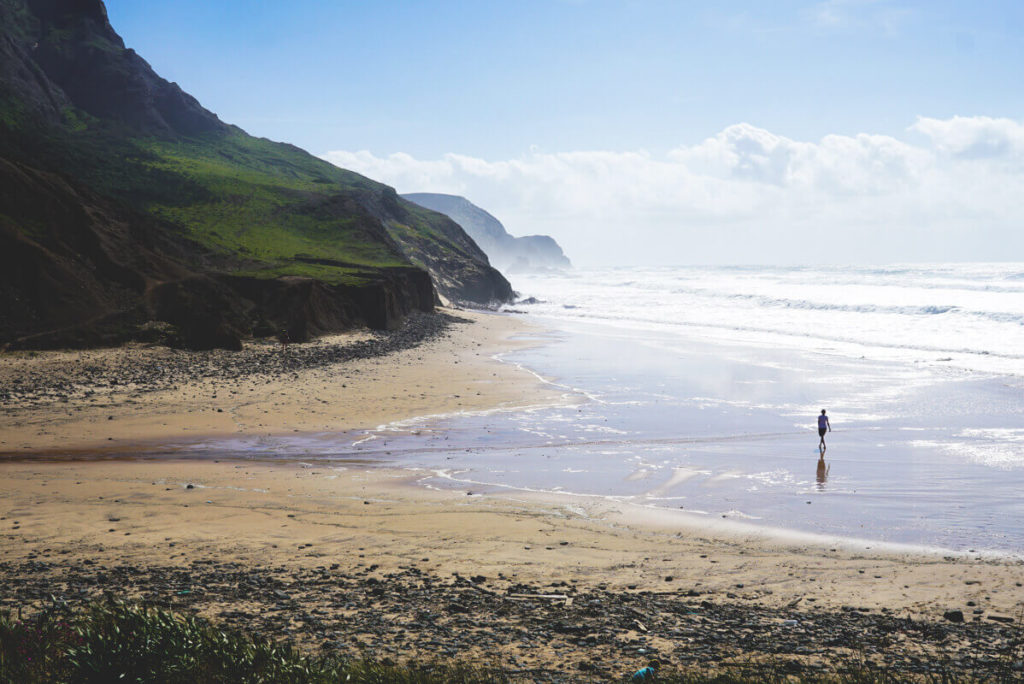
Praia da Armado
After Praia da Cordoama, a few smaller bays follow: Mirouço Beach, Praia da Pena Furada, and Praia da Murração. Directly behind them is Praia do Amado. Here, nature reveals its raw side. While the waves of the cold Atlantic crash overhead, surfers plunge into these daring situations. The expansive beach, the shimmering cliffs, and the black slate rocks create the impression of almost untouched nature.
You can park your car or campervan in the large parking lot at the beach. There are two surf schools on site, as everything here revolves around surfing anyway. Beginners should avoid the water during the winter months, as the power of the wind and water can be difficult for beginners to master.
Beautiful spot at Bordeira’s Beach
One of our favorite spots on the southern west coast is definitely Praia da Bordeira. The cliffs of Cabo Pontal end abruptly, and suddenly a wide valley of beautiful sand dunes opens up. A small river winds its way inland from the sea, spreading out into a lagoon. At low tide, reaching the dunes is no problem. At high tide, however, it might get a bit wetter. We love this wild beauty, the dunes, the surf, and the cliffs.
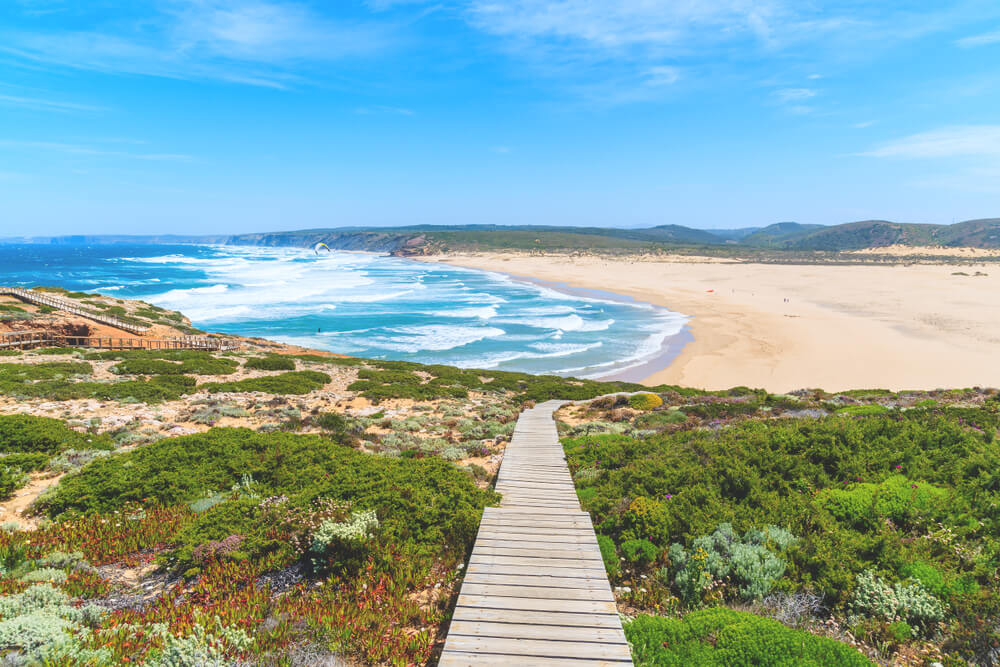
You can hike to beautiful viewpoints via wooden walkways and stairs. There’s a small café in the dunes where you can get inexpensive snacks and drinks. You can park your camper in the large gravel parking lot. We stayed overnight here and had no problems. At least 20 other caravans and campers were there with us (GPS: 37.192749, -8.902577). Nobody was bothered. There are no toilets or showers here. In Bordeira itself, you’ll find restaurants where you’ll probably even be able to use the restrooms every now and then.
Surfing and Chilling in Arrifana
Let’s move on to a great spot for beginners and advanced surfers alike. Arrifana is one of the most famous spots on the west coast and is very popular with surfers. The first time we were there in October, it was really busy. The waves were great for beginners. This time in April, there wasn’t a soul to be seen. The water was rough and wild, the waves quite high. Nevertheless, this place is simply magical and, especially in the evenings, mystical. The view of the bay from the cliffs is breathtaking.
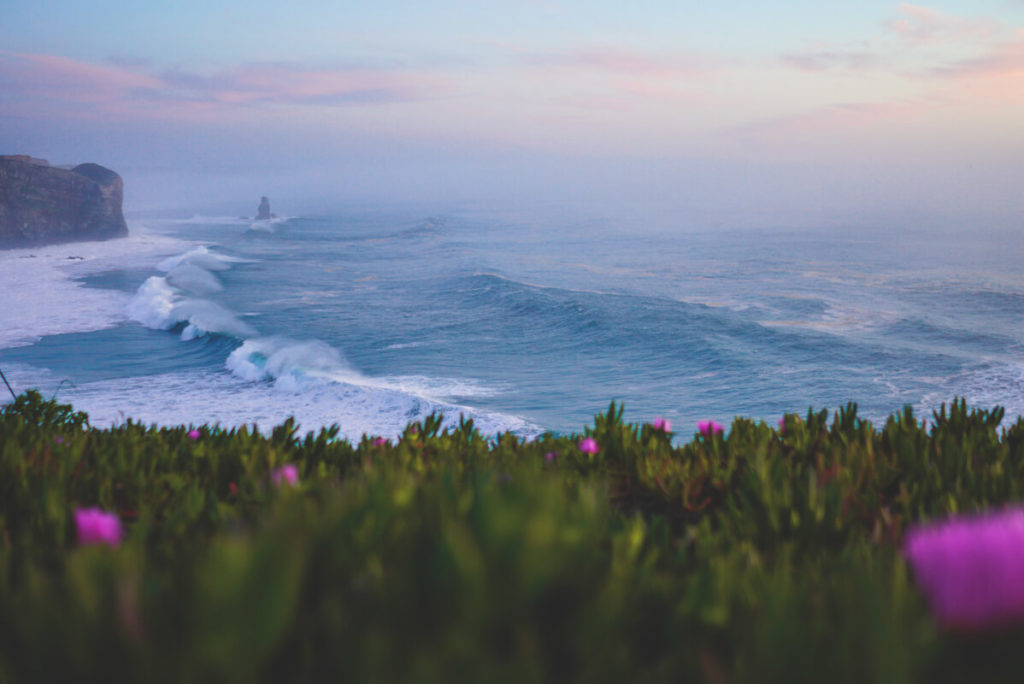
We spent the night in a more remote parking lot, right next to the Arrifana Aljezur Youth Hostel. We were the only ones there, and therefore completely alone. There were no toilets or showers here either. However, there are toilets right down by the beach. According to the internet, there should be showers there, but we didn’t find any. If you ask nicely, you can probably shower at one of the hostels. For breakfast, we went straight to the parking lot (GPS: 37.295728, -8.865891) opposite the Brisamar Restaurant. The view is simply spectacular (see photo).
Take a deep breath in Monte Clerigo
What a small, cozy village right by the sea. Readers gave us this tip, and we drove there directly after Arrifana. The routes are generally never long because the beautiful spots are all close together. Just 15 minutes from Aljezur, you’ll find this great place with a few colorful houses, restaurants, and cafés. The beach is perfect for sunbathing and relaxing. But before you enter the village, you should drive up the road to the cliffs. The view is breathtaking. With the best weather, we lay down in the dunes and enjoyed this wonderful summer day.
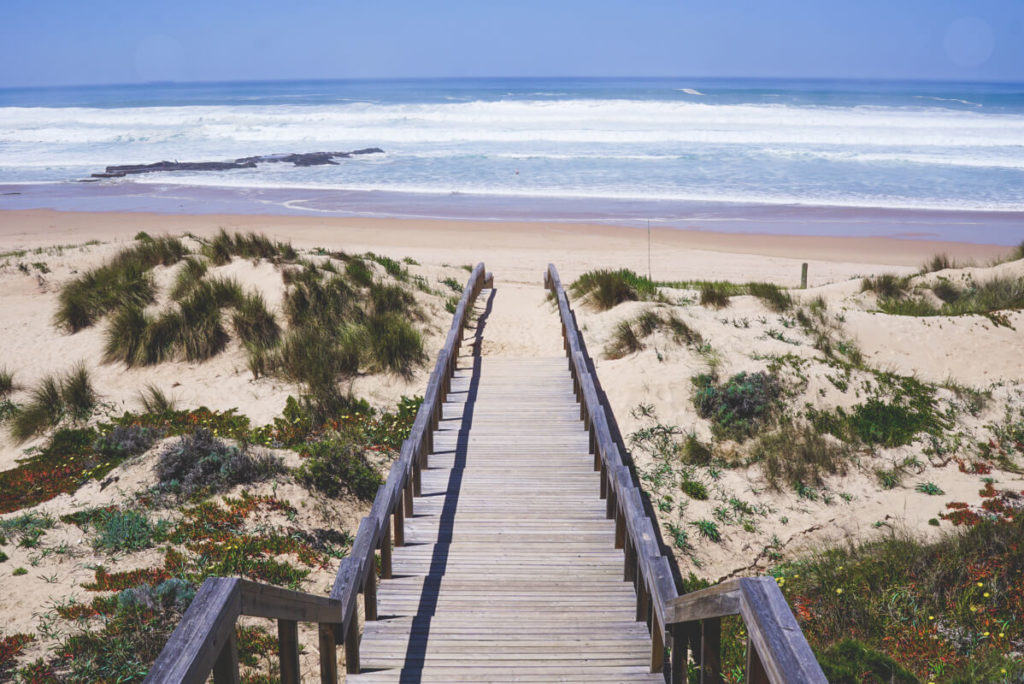
You can park for free right on the beach. We’ve also heard that you can spend the night at this parking lot with a sea view (GPS: 37.349310, -8.849058). To get there, just drive a little further toward the Taberna do Gabriel II Restaurant. Not far from Monte Clerigo is the Serrao’s Park campsite, where you can recharge your batteries, water, etc. You pay only €3.80 per person, and only €5.60 for a larger camper.
Praia de Amoreia
Amoreira Beach near Aljezur is one of the most beautiful in the region. This beach is located at the end of a valley with dark rocks and light sand. The path to the beach is signposted and really easy to find. You’ll find parking on site, as well as the restaurant “Paraiso do Mar” at the end of the beach. Simply follow the long, beautiful wooden stairs down to the sea and enjoy the fantastic view of the beautiful Atlantic.
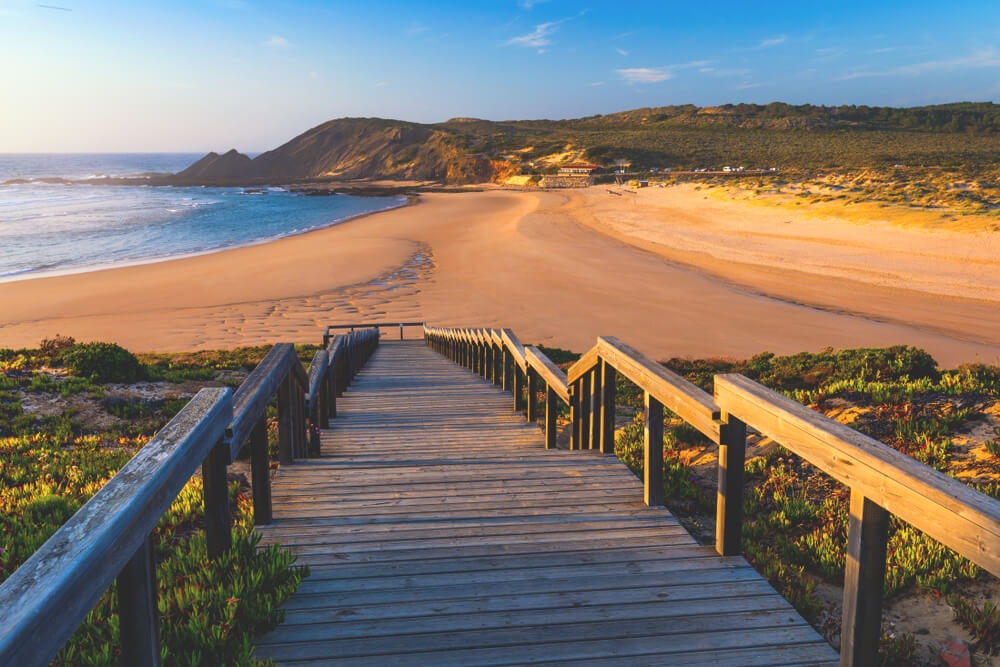
Praia de Odeceixe Mar
This beach is also beautiful and is located in the northwest of the Algarve. The 4-kilometer-long road winds through the green river valley. At the end, it widens, offering a clear view of the beach. If you continue, you will end up in the town of Praia de Seixe. In addition to apartments, bars, and restaurants, you will also find several surf schools here.
The best view of the beach is from the cliffs. To do so, simply continue past the small parking lot to the path that leads up the cliffs. If you drive a little further along the coast, you’ll come to Zambujeira do Mar Beach and Praia Alberta Nova. These two places shouldn’t be missed either.
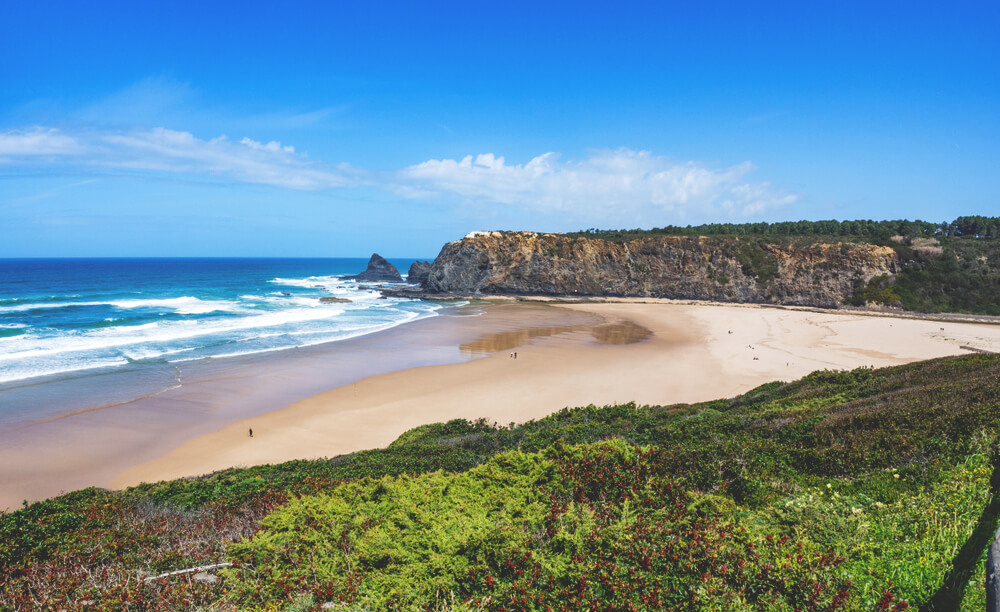
Algarve Round Trip – Route and Duration
Start your trip in Lisbon and explore this wonderful city for at least 1 to 2 days. There’s plenty to discover. Afterwards, you can continue to Lagos with your rental car or camper (3 hours). Find a hotel in Lagos and explore the wonderful bays and beaches of the Algarve from Lagos.
Check out our article about the Algarve, where you’ll find the most beautiful bays, highlights, and tips. Your journey now takes you towards the west coast to Burgau and Sagres, the southwesternmost point of Portugal. Don’t miss the beaches of Bordeira, Arrifana, and small towns like Monte Clerigo and Amoreira. Take your time and drive leisurely along the coast back to Lisbon.
Route Summary
- Route: approximately 642 kilometers
- Travel time: 7 to 8 hours
- Highlights: magnificent surf spots, unique coastlines, rock formations, wild bays, cities
- Duration: at least 7 days, preferably 10 to 14 days
Portugal Round Trip – From Porto to Lisbon
Would you rather see the north and west? How about a trip from Porto to Lisbon (or vice versa)? On this route, you’ll experience a mix of Portuguese flair,Lots of charm, diverse cities, great beaches, and surfing spots. We personally really liked this route. Back then, we traveled from Porto to Lisbon in 6 days. On the last day, we drove back from Lisbon to Porto in our camper van via the motorway (3 to 4 hours drive on the motorway).
You can easily manage the route in a week – for the perfect slow pace, a little more time is obviously a good idea. Especially if you want to take it easy. Personally, we prefer to visit fewer places, have more time there, or rather enjoy the sea and the wonderful views in Portugal.
From Lisbon to Sintra
Sintra is home to beautiful estates, castles, pastel-colored mansions, palaces, and an enchanted fairytale forest. The area is incredibly beautiful and definitely worth seeing – unfortunately, it’s also very touristy. You should definitely plan a whole day or at least half a day for Sintra. Highlights in Sintra in one day include:
- Pena Palace (terraces, gardens, interior tour)
- Sintra National Palace
- Moors Castle
- possibly Pena National Park
If you don’t want to worry about anything and want to gain some background knowledge, we can also recommend a guided tour:
Next we go to Ericeira
Ericeira is a wonderfully charming fishing and surfing village. We love the town’s atmosphere! You should definitely stop here and stroll leisurely through the alleys of the old town. Let your gaze wander over the water or jump into the waves with a surfboard. We’ve already said a few words about Ericeira here: Stroll through Ericeira.
Visit the cool Bamboo Café in the old town and enjoy the sunset in the beach bar on Ribeira d’Ilhas Beach. This is one of our absolute favorite spots in the area. Moreover, Ericeira is somehow like Tarifa in Andalusia. And we also think Tarifa is simply brilliant!
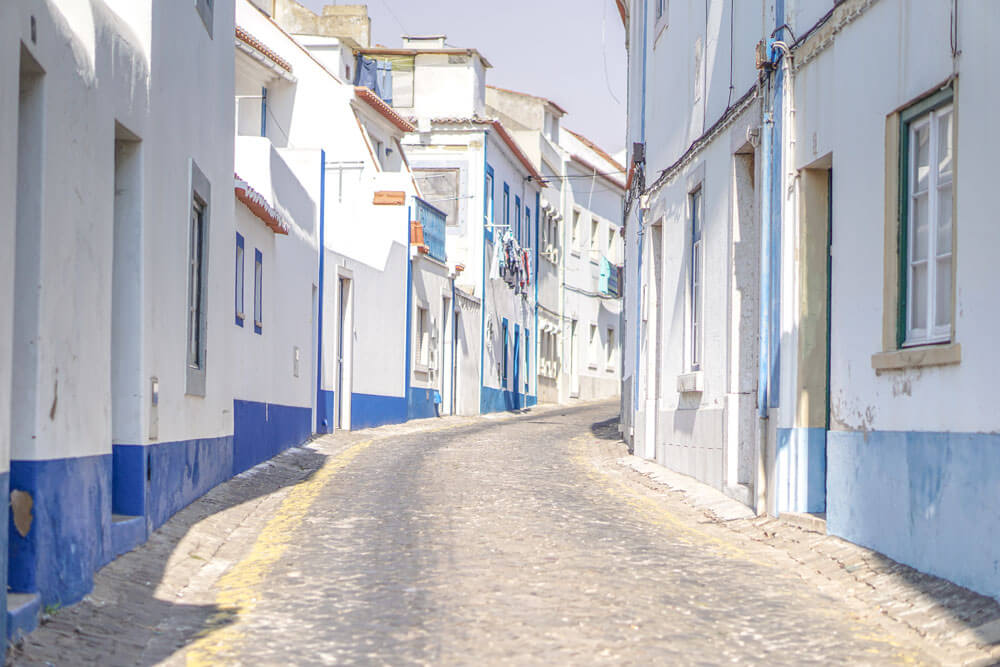
Louriñha & Peniche
If you still haven’t had enough of the sea & If you’re looking for sun, you can look forward to Lourinha and Peniche. Both towns are located directly or not far from the sea, which is something not only surfers appreciate. At Areal Beach in Lourinha, you can relax at a beach bar with a perfect view of the sea. Leave your car there (even overnight) and take a leisurely stroll to Areia Branca Beach. There are many restaurants and bars. Tip: Salty Beachbar or Barraca Bar. Especially at sunset, it’s really relaxed.
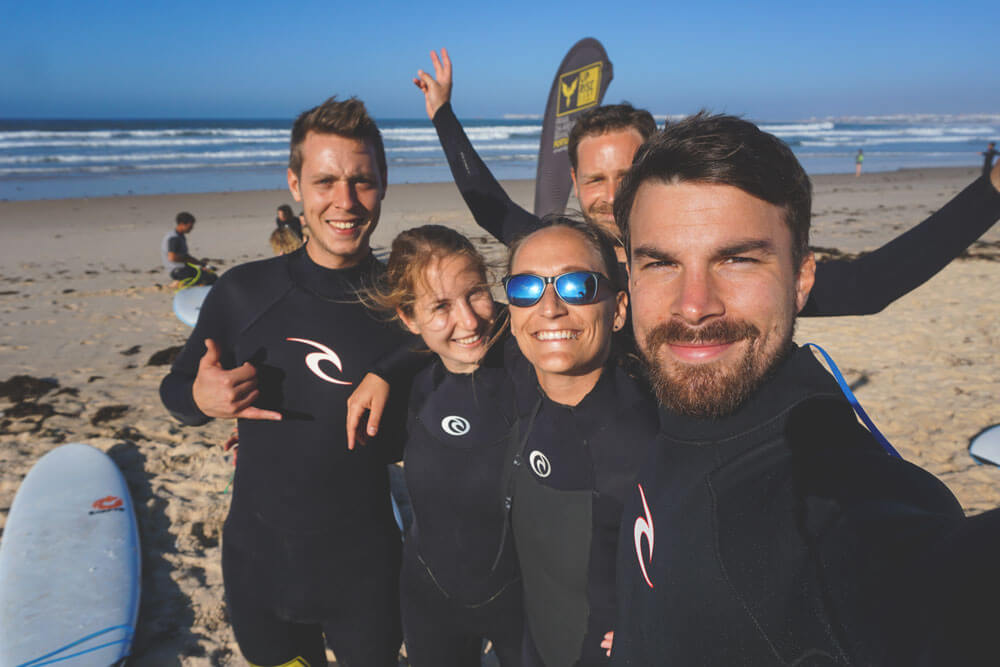
Peniche is known for its many surf spots. Due to the special shape of the coast, there’s always a spot with favorable wind conditions. Many spots are perfect for beginners. These include Bocaxica Surf, Praia Lagide (both sides), and, depending on the swell, Praia do Molhe Leste. If you’re not in the mood for surfing at all, you should take a short detour to the Cabo Carvoeiro Lighthouse & Varanda De Pilatos. The cliffs and surf there are very impressive!
Traditional Village of Obidos
And while you’re in the area, check out the wonderful village of Obidos. It’s a typical Portuguese town surrounded by beautiful city walls. Part of the wall can be accessed, offering beautiful views of both the town and the surrounding area.
Be sure to visit the church at the end of the village’s main street (you’ll see why) and don’t forget to try the local specialty: Ginjinha d’Obido. A cherry liqueur served in a chocolate cup. We’ve already taken several city tours and can absolutely recommend them; the city is truly fascinating!
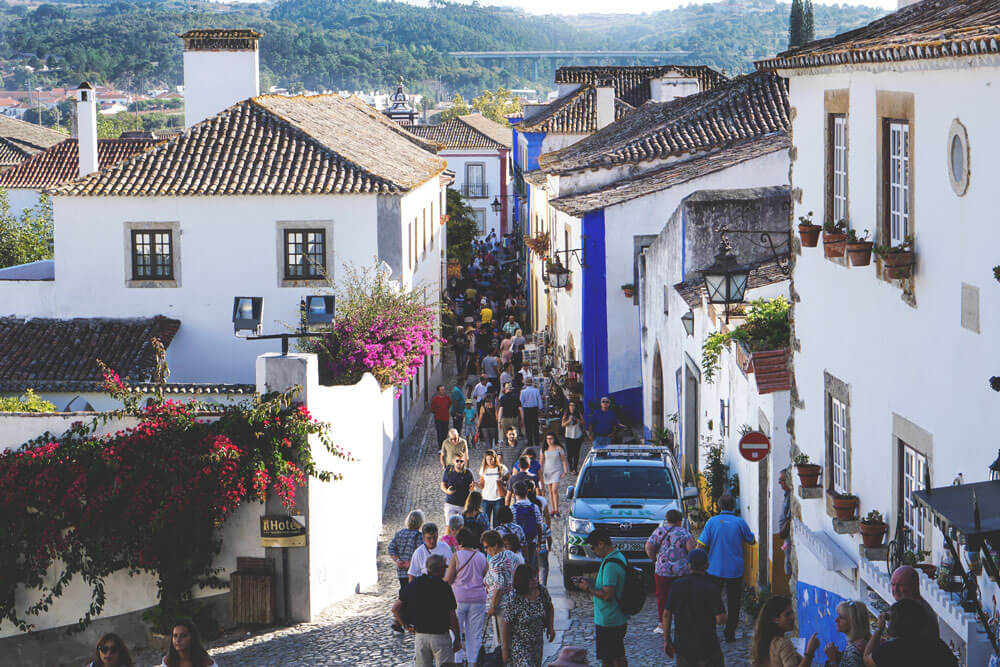
Big Waves in Nazaré
In Nazaré, it’s all about waves, too. But not just any waves, but the biggest waves in the world! There are various reports that talk about the biggest wave ever surfed. The waves there can reach up to 35 meters (!) high. Admittedly, waves that high only occur on a few days a year. But even smaller waves of 10-15 meters are absolutely gigantic to behold. It’s worth stopping by! The best view is from the lighthouse.
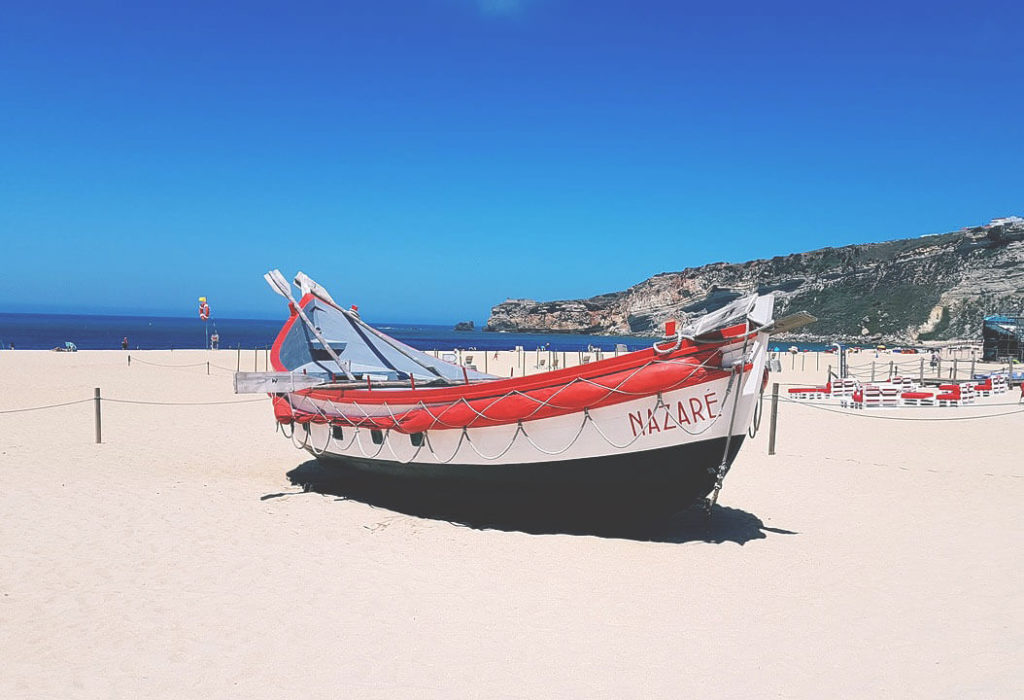
Off to Porto
The road trip was slowly coming to an end. Porto also has a lot to offer, so plan at least 1-2 days here. We particularly liked the Ribeira (waterfront district). The city is very cozy and has a lot of flair. It’s fun to stroll through the streets and alleys, drink a glass of port wine, and enjoy the sunset from one of the many viewpoints. Everything about Porto here.

Summary of the route:
- Route: approximately 450 kilometers
- Travel time: 5 to 6 hours (via highway: 3 hours)
- Highlights: cool cities, surf spots, surf towns, charming villages, wide sandy beaches
- Duration: at least 7 days, preferably 10 to 14 days
Conclusion: Portugal Tour
As you can see, there’s a lot to discover on a Portugal tour. Whether south, west, north, or east – the country is brimming with sights and highlights. You can easily explore the country with a rental car or camper. And even if it’s “just” a city trip to Lisbon or Porto, it’s worth it.
The country is quite affordable, easy to travel, and geared toward tourism. You’ll always find gas stations, supermarkets, restaurants, and cafés. You can even spontaneously find affordable accommodations on site. So you don’t even have to plan and book everything in advance in Germany.